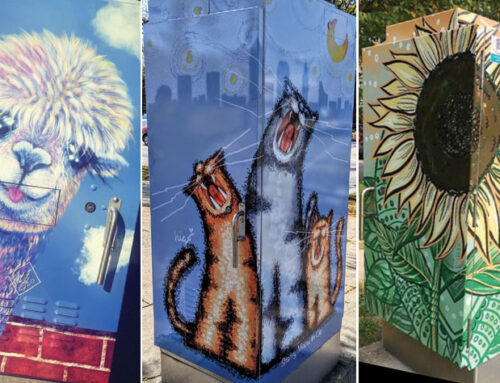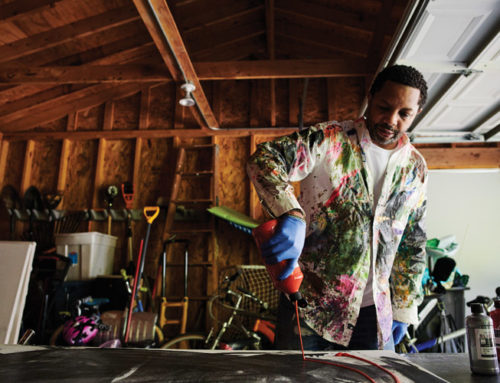When Shaker Life went in search of art in Shaker’s gardens, we found it all across town.
By Rory O’Connor

Robert Indiana’s ART sculpture is among the most notable pieces of Pop Art ever designed.
There is a surprising amount of extraordinary artwork in yards and gardens around Shaker Heights, much of it by regional artists. Some pieces can be seen from the street, while others are nestled in backyards amid flowers and shrubbery. Generally made of stone, metal, or plastic for obvious reasons, some have been commissioned by the homeowners, others purchased from galleries and collections.
Maximizing Visibility
A life-size statue of St. Ignatius Loyola – founder of the Jesuit order – at St. Ignatius High School in Cleveland was the inspiration for this piece, which Rita and Peter Carfagna commissioned from sculptor Norbert Koehn for the garden of their Boulevard-area home.
Koehn points out that while the piece he did for the school is life-size, the statue commissioned by the Carfagnas is smaller, about four feet tall, sculpted from Indiana limestone. It weighs 300 pounds.
The Carfagnas and Koehn chose the statue’s specific site in the garden to maximize the Spanish saint’s visibility. “We chose dark foliage for the background so the statue would stand out, and it’s facing west by southwest for the sunlight.” Koehn needed a small crane to install the piece.
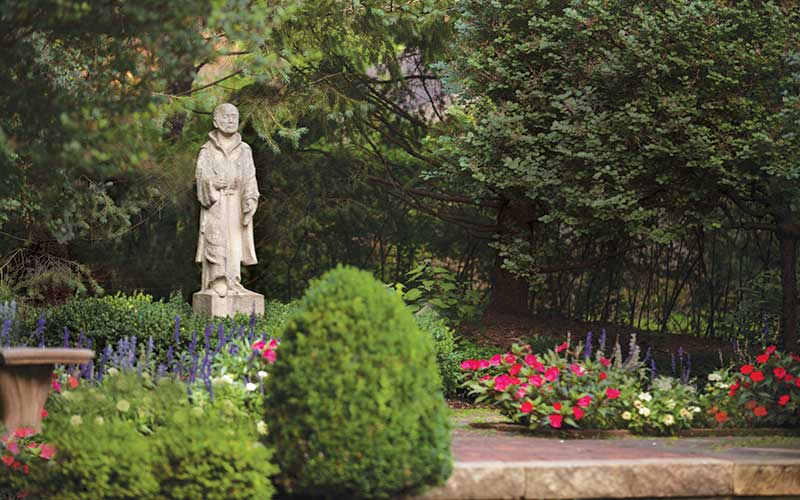
Koehn is a native of the Franconia region of Germany and attended the Bavarian State School for Sculptors and Woodcarvers in Oberammergau, where he met his wife, Victoria, who attended Beaumont School before being drawn to the artistic life in Germany in the 1970s. The couple live and work in South Euclid. Their home on Green Road is the site of Norbert’s studio as well as a lunch-only organic restaurant called the Bavarian Tea Studio at Sanctuary on Green, operated by Victoria.
Koehn has done work for many other churches and religious institutions around Greater Cleveland and Ohio under the name Sacred Design Group. These include a striking reclining figure called “Das Lieben MMX” (Life 2010) in St. Peter Church in downtown Cleveland, and, closer to home, a walnut crucifix at St. Dominic Church.
Some of his more recent works can be seen at University Hospitals and St. Vincent Charity Hospital in Cleveland, and St. John West Shore Hospital in Westlake. His current commissions include churches in Missouri and North Carolina.
Take it Outside
llen Reisman’s late husband Arnold was a true polymath: professor of operational research at the Weatherhead School of Management at CWRU, author, business consultant, and sculptor.
Born 1927 in Lodz, Poland, Reisman survived the Nazi invasion, fled to Russia, and came to the U.S. in 1946. He created his art in a shed behind his and Ellen’s home, much of it from found materials. The yard is literally cluttered with Arnold’s pieces, some in metal, others in wood, and is a delight to the Fernway neighborhood. Ellen says, “So much of Arnold’s work is in the yard simply because he had already filled the house with it. I finally had to tell him, ‘Take it outside!’”
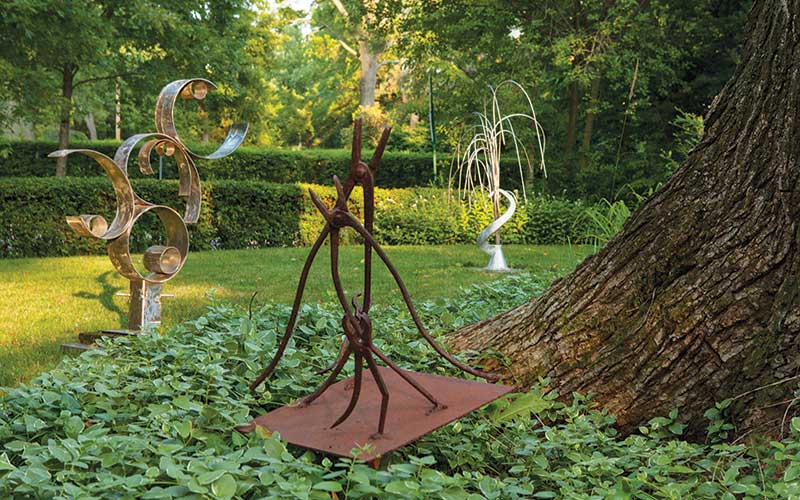
During his life, Reisman exhibited at the Galleria and Agnon School, and was commissioned to do a sculpture for Sabanci University in Istanbul. He also wrote at least 24 books, many of them on Turkish-Jewish relations and management theory. One of his notable successes as a management consultant: the St. Louis Cardinals. “And he hated baseball,” laughs Ellen.
Upcycled Material
Cleveland sculptor Ian Petroni designed “Invasive Species” using vinyl siding that was removed from a Larchmere neighborhood home in an effort to restore the home to its original character. For the 2011 Neighborhoods of Shaker Square Home Tour, Petroni was asked to create an installation using the discarded vinyl siding to provoke critical thought about the use of toxic, unsustainable building materials. He sculpted more than 30 grass-like tufts of varying sizes from the siding, and positioned them in front of the house.
Katharyne Starinsky, one of the founders of the home tour and economic development specialist for the City of Shaker Heights, says, “Ian was inspired by the siding’s ubiquitous, choking nature. After the home tour, the tufts were moved to Felice Urban Café on Larchmere Boulevard, and later sold to individuals,” including the Starinskys. The proceeds from the sales went to the home tour fund. The Starinskys meanwhile installed their purchase in the front yard of their Onaway neighborhood home.
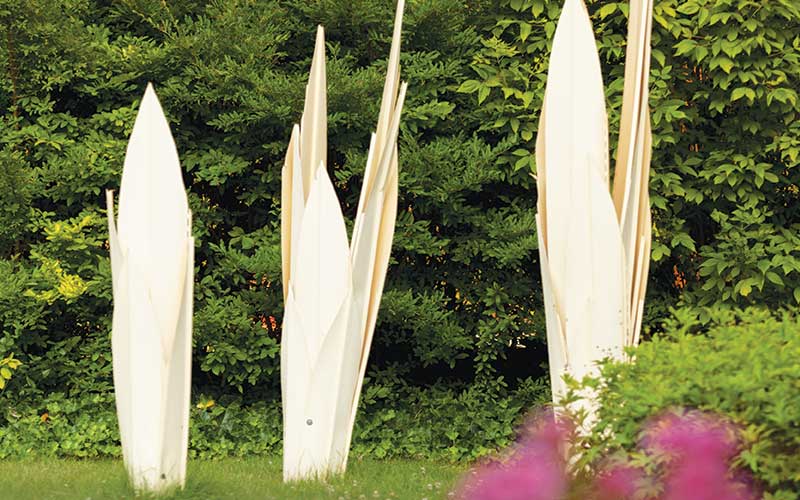
Katharyne says she met Petroni while she was working on the Year of the Dog project for the St. Clair Superior Development Corporation in 2006. “I loved his work, which typically involved upcycled materials, so I thought he would be great for our vinyl siding project.”
To learn more about Petroni and his work, visit ianpetroni.com.
Be What You Is
Ann and Tom Cicarella have two Bennie Collins sculptures in the garden of their Malvern home. The pieces were acquired through a gallery operated by Shaker Life Art Director Deborah Edwards and her husband Mike. The piece pictured here is indicative of Collins’ preference for abstraction, though he did produce some smaller, representational pieces as well.
Collins is a native of Clarksville, Tennessee who lives in Warrensville Heights. He attended Tennessee State University in Nashville and built railroad cars for a living before retiring.
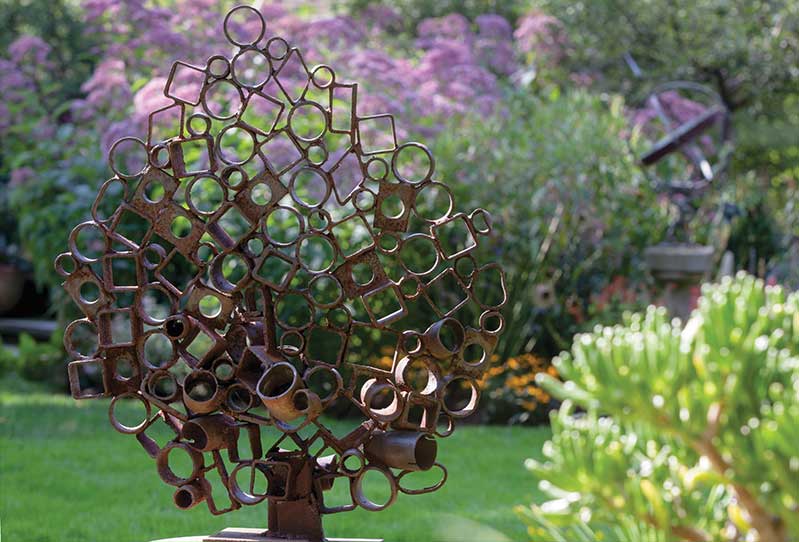
He created his metal sculptures at home in his free time. Based on information on his Facebook page (which has not been updated since 2010), he was motivated by the old saying, “Be what you is, for if you be what you ain’t, then you ain’t what you is.”
Collins exhibited in the Cleveland Museum of Art’s May Show in 1977; Marjorie Talalay, one of the founders of the Museum of Contemporary Art Cleveland, later staged a Collins exhibit at MOCA when it was called the New Gallery – “in the late 1970s, possibly the early ’80s,” recalls Edwards.
A relatively obscure figure, Collins is known primarily by collectors and – as in the case of Talalay and Edwards – gallery operators who specialize in modern and contemporary art. Some of his pieces can be seen on his Facebook page.
Trees and Leaves
Nationally known Ohio sculptor and blacksmith Marte (pronounced “Marty”) Cellura, who has done commissions for Carnegie Hall and the Intercontinental Hotel at the Cleveland Clinic, is represented in Shaker’s Sussex neighborhood by a stunning metal garden arbor he designed and installed for his friends Patty O’Donnell and Bruce Gaynor.
 “Our front yard is a garden, a literal garden, and we had a crappy $99 arbor out there,” Patty says. “Marte was visiting us one day and said, ‘You know, I could build you an arbor.’ We were delighted. Marte’s arbor is one-of-a-kind – the motifs are trees and leaves. He built it at his studio in Ashtabula.”
“Our front yard is a garden, a literal garden, and we had a crappy $99 arbor out there,” Patty says. “Marte was visiting us one day and said, ‘You know, I could build you an arbor.’ We were delighted. Marte’s arbor is one-of-a-kind – the motifs are trees and leaves. He built it at his studio in Ashtabula.”
Cast from forged steel with a bronze address medallion in 2005, the arbor has been featured on the Shaker Historical Society’s Great Gardens of Shaker Heights annual tour.
One of the Originals
Donna and Stewart Kohls’ sprawling front yard has one of the most notable pieces of Pop Art ever designed: Robert Indiana’s ART sculpture (shown at the beginning of this article). The original piece was fabricated in 1972. Only seven were made; the Robert Indiana Foundation retained one.
The Kohls’ piece was fabricated in Polychrome Aluminum in 2001 and installed at their Boulevard neighborhood home some 10 years later. It came directly from Robert Indiana and his foundation, via Contessa Gallery in Cleveland. Steve Hartman of Contessa puts the piece’s dimensions at 102 inches high (8.5 feet), 97 inches wide (a hair over eight feet), and 50 inches deep (about four feet). It’s painted in what Hartman calls “traditional Robert Indiana red and traditional Robert Indiana blue,” and mounted on a black base.
In contrasting ART to Indiana’s most famous piece, the iconic LOVE, Hartman says, “ART is a brilliant follow-up to LOVE. Unlike LOVE, it is very streamlined, architectural, and abstract.” (LOVE is anything but, with the blocky letters L and O mounted atop the V and E, with the O canted to the right. Originally created in the 1960s as a print image, it was later famously issued as an image on a U.S. postage stamp, and fabricated as a sculpture in 1970.)
Hartman credits Indiana with being one of the original conceptual artists as well as one of the first Pop artists. Both movements had their heyday in the mid 1960s. Indiana and Andy Warhol were the movement’s early major influences. Warhol got most of the credit – until now; with the major Robert Indiana retrospective at the Whitney Museum of American Art in New York this past year, his place in art history has been elevated and secured.
Indiana’s local representatives can be reached at contessagallery.com.

